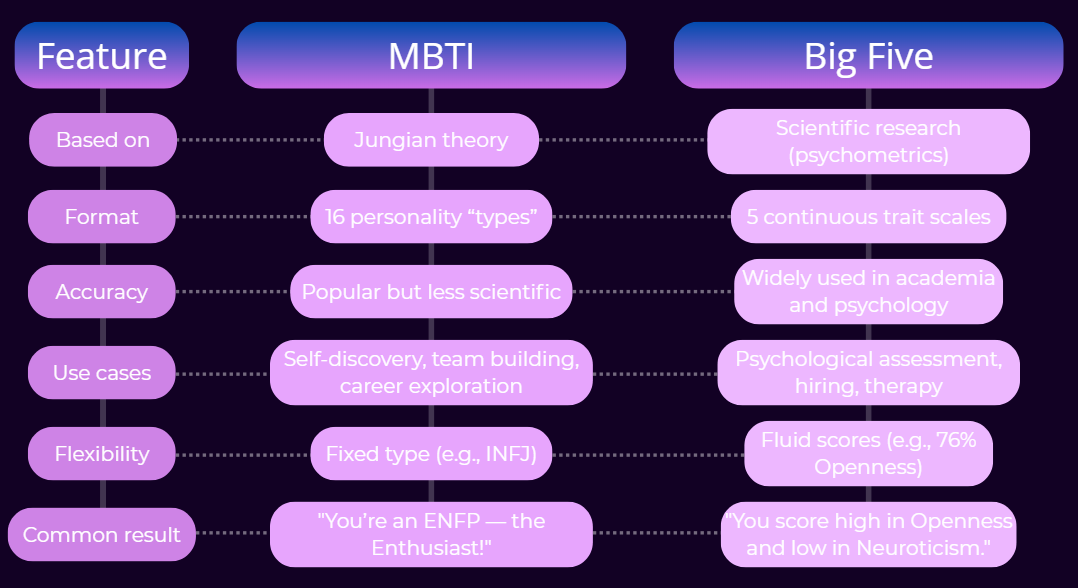MBTI vs. Big Five: Which Test Describes Your Personality Better?
In the world of online personality tests, two names stand out more than any others: MBTI (Myers–Briggs Type Indicator) and the Big Five Personality Traits. You’ve probably seen both: maybe you know you're an INFJ or ENTP, or maybe you've taken a test that measures traits like "openness" or "neuroticism."
But what’s the real difference between them? And which one gives you a better understanding of who you are?
Let’s break it down - with examples - to help you decide which framework suits you best.
What Is MBTI?
The Myers–Briggs Type Indicator (MBTI) is based on the work of Carl Jung, later expanded by Katharine Cook Briggs and her daughter Isabel Briggs Myers. It divides personalities into 16 unique types, based on four binary preferences:
- Introversion (I) / Extraversion (E) - where you focus your energy
- Sensing (S) / Intuition (N) - how you process information
- Thinking (T) / Feeling (F) - how you make decisions
- Judging (J) / Perceiving (P) - how you interact with the world
- Each person gets a 4-letter “type” - like INTP, ESFJ, ENFP, etc.
Example:
ENFP: Energetic, imaginative, loves exploring new ideas and connecting with others. Often called “The Campaigner.”
ISTJ: Responsible, detail-oriented, and loyal. Known as “The Inspector” or “The Logistician.”
What Is the Big Five?
The Big Five (also called OCEAN) is a scientifically validated model of personality that focuses on five key traits:
- Openness to Experience - creativity, curiosity, imagination
- Conscientiousness - organization, discipline, goal-setting
- Extraversion - sociability, energy, enthusiasm
- Agreeableness - kindness, empathy, cooperation
- Neuroticism - emotional reactivity, stress, anxiety levels
Instead of placing you into a “type,” it shows where you fall on each scale, giving a more nuanced, flexible portrait of your personality.
Example:
Someone might be high in Openness, medium in Extraversion, low in Neuroticism, etc.
Your result could look like a radar chart or detailed breakdown.
MBTI vs. Big Five: Head-to-Head
So... Which One Is Better?
It depends on your goal:
👉 Choose MBTI if:
- You enjoy quick, easy-to-understand labels
- You want a character-like profile that’s relatable and fun
- You're exploring identity through pop culture, career roles, or relationships
- MBTI is great for self-reflection, even if it’s not as scientifically precise.
👉 Choose Big Five if:
- You want a more scientifically reliable result
- You’re interested in mental health, psychology, or behavioral prediction
- You like complexity and don’t need a simple label
- Big Five is ideal if you're looking for a deeper, more accurate picture of how your personality works in the real world.
Can You Use Both?
Absolutely! Many people start with MBTI for fun and quick insight, then go deeper with the Big Five to get a more comprehensive understanding of themselves.
In fact, on testportal.gg, you can explore tests based on both models - from “Which MBTI Type Are You?” to “How Emotionally Stable Are You (Big Five Scale).”
Combining both gives you the best of both worlds: the clarity of a label with the depth of a spectrum.
Final Thoughts
MBTI and Big Five aren’t enemies - they’re different tools for different types of thinkers. One gives you a personality “nickname,” the other paints a detailed portrait.
Whatever you choose, remember: no test defines you completely - but it can guide you toward understanding your strengths, tendencies, and potential.
🔜 Coming soon:
“What Your MBTI Type Says About Your Ideal Morning Routine”
and
“How Big Five Traits Affect Your Relationships (With Quiz!)”

